The Swiss Due to the different languages and cultures in the country, the kitchen has influences from the Italian, German and French cuisine. A wonderful variety of local dishes has been preserved in the different regions. Well-known specialties are raclette, cheese fondue, Zürcher Geschnetzeltes, hash browns and other dishes. Polenta and risotto are popular in the south. Switzerland is also known for its diverse types of cheese and chocolate.

cheese
Cheese dishes
- Raclette is a typical winter food of the mountain regions. Cheese is melted and served with jacket potatoes, pickles, pickled onions, mustard fruits, etc.
- Cheese fondue is a dish made from melted cheese in which pieces of bread are dipped. The basic ingredients are cheese, white wine, some kirsch and cornstarch to thicken, garlic, some nutmeg and pepper, whereby the character of the fondue is determined by the types of cheese used.
- Moitié-moitié (French for half-half) consists of half of Vacherin and half of Gruyere.
- The Appenzell fondue is made only from Appenzell cheese.
- Fondue fribourgeois In the canton of Friborg, Vacherin is made with the Freiburg cheese, sometimes from Vacherin and Gruyere in equal parts.
- A mixture of two parts Gruyère and one part raclette cheese is common in Geneva.
- In Eastern Switzerland, a mixture of equal parts Gruyère, Appenzeller and Tilsiter is preferred.
- Around Basel there is a mixture of equal parts Gruyère, Vacherin and Appenzeller.
- At a Cheese slices (Cheese cuts) a bread slice is coated with a mixture of grated cheese, flour, milk or cream and egg yolk and then fried in oil or butter, or prepared in the oven. The dish is usually served with a salad or a fried egg.
- Cheese pancakes is a yeast dough with a topping of grated cheese, eggs and chopped onions, seasoned with salt, pepper and nutmeg.
- The Appenzeller cheese cake, Cheese flatbread, is made either with bread dough or yeast dough and of course the topping consists of Appenzell cheese

Cheese fondue with pieces of bread

Cheese slices
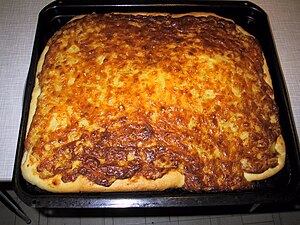
Cheese pancakes
- Chäsgatschäder consist of cheese and bread and is in the Prättigau popular. The bread is fried with onions, boiled with milk, the cheese is dissolved in it and stirred until creamy.
Swiss cheese
You could only travel from cheese dairy to dairy in Switzerland. In every part of the country, in every region, there are different types of cheese, an unbelievable variety from a single basic product.
- The spicy one Appenzeller is a raw milk cheese
- The world famous Gruyere, Gruyere, is a semi-hard to hard hard cheese made from raw milk with a protected designation of origin (AOP). That is why it can only be produced in the cantons of Vaud, Neuchâtel, Friborg and Jura, the districts of Courtelary, La Neuveville, Moutier and some Bernese municipalities.
- The holey one Emmentaler originally from Switzerland, but is now produced worldwide. The large holes are typical for him. The bubbles are caused by bacteria that release carbon dioxide. The addition of hay dust serves as a trigger for gas formation.
.jpg/300px-Appenzeller_(cheese).jpg)
Appenzeller

Emmentaler
- The Sbrinz is a hard cheese that is one of the oldest types of cheese in Europe. It is made by hand using traditional methods in copper kettles in the cantons of Lucerne, Obwalden and Nidwalden
- The melting and soft one Vacherin Mont-d'Or is a soft cheese made from cow's milk, which comes from the Swiss Jura, the area around the Lac de Joux and the Vaud Jura.
- Vacherin fribourgeois is a semi-hard cheese from the canton of Friborg, which is often used for cheese fondue.
- The one scraped into decorative rosettes Tete de Moine is made from untreated cow's milk in the Bernese Jura and in the canton of Jura. The special tool for this, a crank-like cheese slicer, is called a girolle.

Vacherin Mont-d'Or
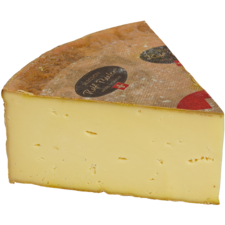
Vacherin Fribourgeois
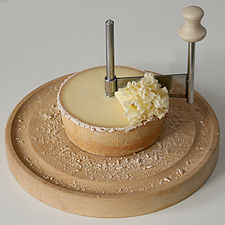
Tete de Moine
- Schabziger is a cheese specialty from the canton Glarus. Skimmed milk is heated to 90 ° C, then flocculated through a lactic acid culture. This creates the so-called Ziger. This is weighed down in perforated butter and fermented for four to twelve weeks. The matured Ziger is then grated, salted and stored for three to eight months. Then powdered black clover (Trigonella caerulea ssp. Sativa) is added and the powder is in its typical shape for six to eight days Zigerstöckli pressed. Finally, dry on a scaffold for two to six months and it's done.
- The cheese is grated and mainly used to flavor dishes. For example Zigerhörnli (Pasta with ziger), Ziger fondue or Zigerbrood (Bread and butter with Ziger). You can buy it in grated form, or the classic one Schabzigerstöckli, of which you can rub the desired amount. There is also Ankeziger, Ziger mixed with butter in a mug that can be spread directly on bread.

Schabzigerstöckli to grate
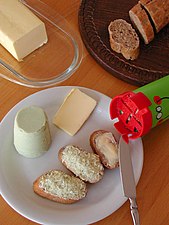
Zigerbrüt
The treasure trove for cheese specialties are the stalls of farmers and cheese dealers at the weekly markets. The cheese often comes directly from the alp. The many show dairies and alpine cheese cellars in the country are also worth a detour or excursion.
Meat (meat and meat)
- Zurich sliced meat (Züri-Gschnätzlets, fr. émincé de veau zurichoise or émincé à la zurichoise) consists of veal, veal kidneys and mushrooms with a cream sauce, with hash browns, but also pasta, rice, or mashed potatoes (mashed potatoes)
- Meat birds are in Germany as Roulades, in French-speaking Switzerland Paupiettes, in Ticino Involtini (Wrapped) or Uccellini (Little bird). Thin slices of beef or veal are topped with bacon, onions or other ingredients, rolled up and then fried.
- Prättigau Chnödli are spicy meatballs from the Prättigau, which are served with sauce and various side dishes, often with vegetables.
- Bündner meat is a specialty and registered trademark in Grisons. Beef that has been freed from tendons and fat is cured with salt, saltpeter and spices for a few weeks near freezing point and then air-dried for 3-6 months. During the drying process, the meat is pressed several times, which also gives it its rectangular shape. During this process, the meat loses half of its weight - the result is a spicy ham that, cut into very thin slices, melts on the tongue. The Bündnerfleisch is usually eaten with bread, but is also used cut into fine strips or cubes for capuns (see below) or as a soup.
- 1 Jörg Brügger & Co - Traditional meat drying facility, where the popular Bünderfleisch is still produced today in traditional handicraft. The «Lädali» with many specialties can be found on the ground floor of the farmhouse
Bündner meat

Dried meat using the traditional method
sausage
- The St. Gallen bratwurst also bears the name OLMA sausage after the annual OLMA (Eastern Switzerland Agricultural and Dairy Exhibition). It is a fine, white bratwurst that Bavarian White sausage similar in color, size and consistency. However, it is not heated in water like the white sausage, but only fried. The bratwurst consists of at least 24% veal, a maximum of 20% pork as well as milk or milk powder and milk protein and various spices. It is registered as a protected geographical indication (GGA) and is only allowed in a certain area in and around St. Gallen to be produced. The small bratwurst weighs 115 grams, the OLMA bratwurst 165 grams and the St.Galler Kinderfestbratwurst is the heavyweight at 220 grams. In the summer, a 500-900 gram, snail-shaped rolled up sausage is produced, which is called Schnägg referred to as. It comes with a traditional bun, the St.Gallen Bürli, eaten, which is served separately. The St. Gallen bratwurst is served without mustard or other sauces. Eating them with mustard is considered a big taboo. Anyone who does it anyway shows that he is not a local.
- The Ticino Luganighetta is a raw pork sausage. It is twisted into a snail and held in shape by a skewer. It can be fried or combined with other dishes such as risotto.
OLMA sausages
St. Galler Bratwurst, St. Galler Schüblig and Cervelat
- A specialty in the canton Vaud are the Saucisson from Vaudois (Saucisson vaudois), or Saucisson aux Choux, (cabbage or cabbage sausage). They can be cooked or dried, eaten warm or cold. The hearty sausage, which is cooked for around 40-50 minutes, is often eaten with papet vaudois, a leek and potato puree.
- The Longeole is a traditional raw pork sausage with a protected designation of origin from the region Geneva. The difference to other sausages are the fennel seeds and the rind, which should not be missing in the sausage. The raw sausage has to be cooked for between 2 and 3 hours at around 70 ° C to get the rind soft. The Geneva specialty is usually served with artichoke or potato gratin, potato or carrot salad are also possible.
- Salsiz are small salami from Graubünden
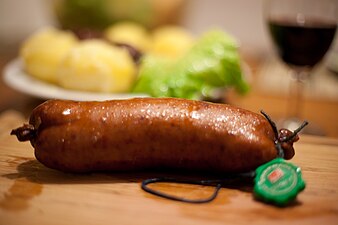
Saucisson vaudois

Longeole
Salsiz
- The Cervelat, Zervela, in Basel Klöpfer, in St. Gallen Stump, in French-speaking Switzerland Cervelas called, is a smoked boiled pork sausage. It is not to be confused with Zervelatwurst in Germany, it is more similar to the German Bockwurst. It can be used in many ways, it is eaten cold in a sausage salad, warm or grilled. Some also refer to them as the Swiss national sausage.

Cervelas
fish
- Egli (Perch, Perca fluviatilis) is also used on the German side of Lake Constance Kretzer called. The fillets are best steamed or seared gently and served with various side dishes. At Perch crispy the fish fillets are fried in beer batter and served with boiled potatoes and tartar sauce.
- in the Lake Geneva there is a lot of fish like pike, perch and whitefish. Quenelles au Poissons (Fish dumplings) are in the Geneva Area a popular specialty.
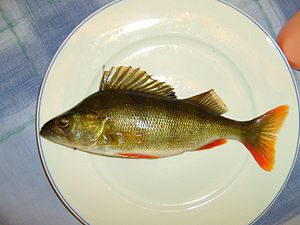
Egli whole
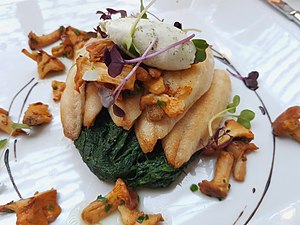
with chanterelles and spinach
Soups
- Graubünden barley soup: Rolled barley (Swiss for pearl barley) is cooked in a clear broth with potatoes, celeriac and other root vegetables, then Bündnerfleisch, ham, bacon or sausage are added.
- In the Hay soup a broth is first cooked with hay, then strained, vegetables are cooked soft in it, mashed and finally refined with cream (full cream).

Graubünden barley soup
Side dishes
- The Hash browns is a flat, pan-fried flat cake made from grated boiled or raw potatoes or a mixture. Around Zurich the raw potatoes are preferred, in the west around Bern and in French-speaking Switzerland the cooked ones are preferred. In the vegan version, the potatoes are only bound by the starch they contain. The Emmentaler Rösti can be fortified with bacon that Berner Rösti is poured with a little milk and then fried again.
- Gschwellti the jacket potatoes are called in Swiss German.
- polenta is a solid porridge made mostly from corn grits, which is mostly served in the Italian-speaking part. Bramata is a variant made with coarse corn grits in Graubünden.

Hash browns
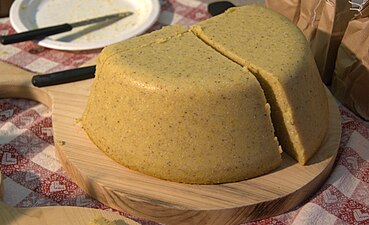
polenta
More dishes
- Capuns is a packet of spaetzle dough that is wrapped with chard, lettuce or spinach leaves. The traditional dish from the Canton of Graubünden is enriched with chopped salsiz or Bündnerfleisch. Capuns are boiled in milk water and, depending on the recipe, baked with mountain cheese. A sauce made from the milk water (half bouillon and milk) is served with this.
Capuns in the Valsertal

Capuns in Lenzerheide
- Älplermagronen are a kind of gratin from the Swiss alpine area, which consists of potatoes, macaroni, cheese, cream and onions. Applesauce is served as a side dish.
- Pizokel are a specialty from Graubünden. The pasta is reminiscent of spaetzle, made from grated potatoes, wheat flour, eggs and milk. There are many ways they can get on the table. They are served with melted butter, toasted breadcrumbs, au gratin, or with fried bacon, onions and grated cheese, or with vegetables such as savoy cabbage, spinach, chard.

Älplermagronen
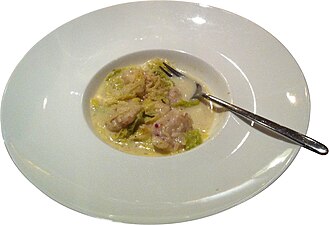
Pizokel
- Bircher muesli was developed around 1900 by the Aargau doctor Bircher-Brenner, made from oat flakes, lemon juice, sweetened condensed milk, grated apples, almonds or hazelnuts. Today it should hardly be missing on a breakfast buffet in a hotel.
Pastries
- The Vully cake (Gâteau du Vully, Wistenlacher Kuchen) is a yeast dough cake from French-speaking Switzerland that is available in a sweet and salty version. The sweet version is covered with creme Gruyere (double cream, double cream), the salty version is seasoned with bacon and caraway seeds. The cake is sold at village and winemaking festivals.
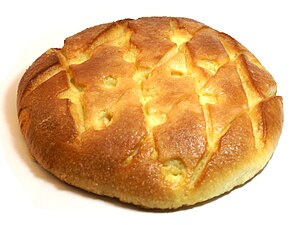
Vully cake
<
Sweets
- The Carrot cake is a carrot cake from the Aargau. The sponge cake with carrots and nuts is usually decorated with small marzipan carrots and chopped hazelnuts or almonds around the edge.
- The Zug cherry cake consists of two japonais bases (meringue) and two sponge bases with cherry syrup and a filling of cherry pie cream. The cake is dusted with powdered sugar and the edge is decorated with toasted almond slices. The cake is protected by law, it is only allowed in the canton train can be made with Zug cherries or Rigi cherries.
- 1 The Zug cherry cake museum shows over 200 original exhibits, documents and pictures from the 100-year history of the Zug cherry cake. The Zuger Kirschtorte Meile in the Neustadt district shows the history of Zug cherries, Zug cherry water and Zug cherry cake with 5 rotating picture stations.

Rueblitorte
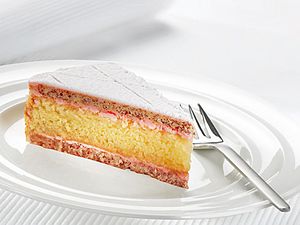
Zug cherry cake
- Glarus patties are a puff pastry from the canton Glarus which is filled with plum and almond filling. They consist of a central part around which another 8 to 24 parts are grouped. Smaller ones with a diameter of about 7 centimeters will also be used Beggeli called.
.jpg/337px-Glarnerpastete,_frisch_zubereitet_in_den_Bäckereien_in_der_Gemeinde_Glarus_(24985978132).jpg)
Glarus patty complete
Beggeli
- Vermicelles is a Ticino Dessert made from boiled and pureed chestnuts, refined with butter, syrup, vanilla sugar and kirsch and eaten with whipped cream. The chestnut mass is pressed through a perforated sheet, creating "worms" about 15 cm long. The chestnut worms can also be taken home as a souvenir in the tube.
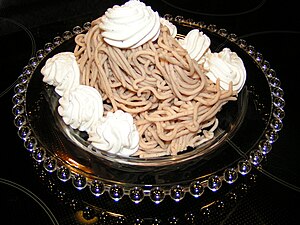
Vermicelles
- Nidelzeltli are cream caramels
- Appenzell beaver is a gingerbread biscuit with an almond marzipan filling. It is called round Biberli Eaten as Z'Vieri, larger beavers with embossed representations are more like souvenirs, birthday or Christmas presents.
- Birebrot with a dark filling made from dried pears and nuts are typical Appenzell baked goods.
- The Bündner pear bread consists of yeast dough with a filling of dried pears, sultanas, nuts, often figs or dried apples. Traditionally, pear bread was served in Graubünden at the turn of the year, but it is now available all year round.

Bündner pear bread
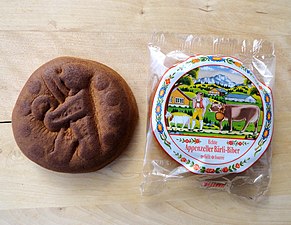
Appenzeller Biberli
Swiss chocolate
Chocolate came to Europe in the 16th century, and also to Switzerland in the 17th century at the latest. In the second half of the 19th century, the reputation of Swiss chocolate spread abroad. This goes hand in hand with the invention of milk chocolate in 1875 by Daniel Peter and conching in 1879 by Rodolphe Lindt. You can find out more about Swiss chocolate on the website of the Association of Swiss Chocolate Manufacturers.
Ingredients (Zuadada)
- Blue St. Gallen is a newly bred potato variety from Switzerland with blue-violet meat. The color is retained during cooking and deep-frying, which is what makes this type of potato so special. The Migros and Coop supermarkets sell the potatoes and also have blue potato chips on offer.
- The chestnut used to be a poor people's meal and now frowned upon. Today she mainly celebrates in Ticino a comeback in many areas, from jam, honey, cakes to bread, puree, pasta to beer and grappa. Candied chestnuts, marrons glacés, are a good dessert.
- At Cardon genevois (German Kardy) is a vegetable that is reminiscent of artichokes. Many farmers in the Geneva region grow thistle-like vegetables. The raw stalks are often doused with bechamel sauce and baked with cheese. But it is also sold as a canned product in a jar.

Cooked Blauer St. Gallen with melted raclette cheese

Cardon epineux genevois
beverages
Wine
Swiss wines are hard to come by outside the country, most of them are drunk directly in Switzerland; only a very small part is exported. The demand exceeds the amount of wine grown, which leads to high prices. Around 200 different grape varieties are grown, many of which are internationally known, but there are also autochthonous varieties that are only represented locally, e.g. Humagne Blanc from the canton of Valais. Probably the most famous white wine variety is the Müller-Thurgau. The new wine breeding was started in 1882 by the Swiss Hermann Müller-Thurgau from the canton of Thurgau at the Geisenheim research institute im Rheingau bred. A specimen of the original grapevine has been preserved in Wädenswil on Lake Zurich.
Official wine regions are the cantons of Valais, Vaud, Geneva, Ticino and the Three Lakes Region (parts of the cantons of Bern, Friborg and Neuchâtel) in western Switzerland and the cantons of Zurich, Schaffhausen, Aargau, Lucerne, as well as Lake Thun and the Bündner Herrschaft .
There are three categories in the Swiss Wine Ordinance:
- Category I. is the highest level. They are controlled appellations with a controlled designation of origin. The name is AOC followed by the name of the region. For some municipalities, the term Grand Cru is permitted in this category.
- Category II is a country wine, Vin de Pays, with Designation of Origin
- Category III are table wines without a designation of origin
- 2 Wine museum in Boudry Castle As the name suggests, this is dedicated to wine.
Wines
- Cornalin is a red wine that is particularly grown in the canton of Valais. The wine should only be drunk after three to five years, when it develops intense spicy notes and the tannins subside. The AOC wine made from the Cornalin grape variety is the Cornalin du Valais, a Grand Cru. It may only be put on the market after April 1st of the second year after harvest.
- The Valais is an AOC-certified rosé wine Rosewhich can contain up to 10% Valais AOC white wine.
- White dole
- Œil de perdrix du Valais
- Rosé de Goron
- Are red and white grapes from the same vineyard mixed and pressed together before fermentation. Then in Valais one Schillerwein spoken.
beer
The Feldschlösschen brewery has a market share of over 40 percent in Switzerland and is therefore the undisputed number one, it is owned by the Danish Carlsberg. This is followed by the Dutch Heineken Group, which has a market share of around 20 percent. This means that over 60 percent of the Swiss beer market has already been taken. There are also a dozen medium-sized breweries. The last 4 percent of the market is shared by around 600 smaller, local breweries, which are the most interesting for tourists.
- 3 In the visitor center Brauquöll the Locher Brewery in Appenzell there are interesting things to see about the art of brewing and the Säntis malt whiskey. In the historic hop cellar, a short film screening gives an insight into the brewery, and a small museum shows the old days. You can buy beer and various fan articles in the shop.
Beer glasses and beer measures
| description | Size in liters | area | annotation |
|---|---|---|---|
| cups | 0,3 | german-speaking Switzerland | for lager |
| Canette | 0,5 | Western Switzerland, especially Freiburg | Specification for beer in the glass |
| Chope | 0,5 | French-speaking Switzerland | in the glass beer mug |
| Chubel | 0,5 | German-speaking Switzerland west of Zurich | |
| Chubeli | 0,3 | german-speaking Switzerland | |
| bottle | 0,58 | Eastern Switzerland | for lager beer in half-liter or 58-cl bottles |
| Flute | 0,2 | Canton of Valais | |
| Galopin | 0,2 | Geneva | |
| Gambrinus | 0,4 | german-speaking Switzerland | |
| Herrgöttli | 0,2 | german-speaking Switzerland | |
| Sleeve | 0,5 | german-speaking Switzerland | Used for beer in the bottle, especially for half-liter cans |
| Tankard | 0,5 | german-speaking Switzerland | in the glass beer mug |
| Little one | 0,3 | german-speaking Switzerland | was originally a third of a liter, today only 0.2 liters, especially in gastronomy to distinguish it from large beer |
| jug | 1,0 | german-speaking Switzerland | |
| bucket | 0,5 | western German-speaking Switzerland, central Switzerland and Bern | |
| Measure | 1,0 | german-speaking Switzerland | |
| Mini | 0,2 | Switzerland, especially in Valais | |
| Rugeli | 0,3 | Basel and the surrounding area | in a bulbous glass with a handle |
| Special | 0,33 | Eastern Switzerland | stands for both the shape and size but also for the content of the bottle of "special beer" |
| pole | 0,3 | german-speaking Switzerland | Generally for lager beer by the glass |
Schnapps and liqueurs
- Träsch is a popular apple brandy
- Bätziwasser is a clear schnapps made from dried apple wedges with an alcohol content of 40% vol., which is mainly used in the canton Obwalden is produced and consumed.
- The Alpine bitter is a dark bitter made from herbs with an alcohol content of around 30% vol. He will be in Appenzellerland and in the region around Lucerne produced. The best known is the Appenzell alpine bitter.
- 4 The production of the Appenzell alpine bitters Can be visited without prior notice, every Wednesday, from April to October, at 10 a.m. in German, the duration is approx. 1.5 hours.
- Röteli. is a red-brown liqueur with around 26% vol. Alcohol off Grisons. It is flavored with a spice mix of cinnamon, cloves, vanilla and other spices that differ locally, as well as sugar syrup and cherry juice.

Röteli
- Damassine is a brandy made from the damassine plum variety in the canton of Jura and mainly in the Ajoie. The damassine is the small plum that is pink-red on the sunny side and yellow-orange on the shady side. The yield of the trees varies from year to year. The fruits are hand picked as soon as they are ripe and fall to the ground. After the harvest, the fruits are completely filled into barrels without being pitted or crushed. They are then distilled in traditional stills to obtain a brandy with a minimum alcohol content of 40 °. This is after two to three years of storage eau-de-vie ripe for enjoyment.
Soft drinks
- Rivella is a non-alcoholic, carbonated soft drink with 35% whey that is available in Rothrist in the Aargau will be produced. The national drink is number 2 after Coca-Cola in Switzerland and is now also sold in other countries. There are different varieties, Rivella red, blue (Rivella light), green (with green tea extract), peach, rhubarb and mango tropical.
- Orange must is a carbonated, non-alcoholic drink made from orange and apple juice that is available in the Eastern Switzerland and Beckenried / NW is a specialty with tradition. The Beckenried orange must is well known.
- Gassosa (Gasosa, Gazosa or Gazzosa) means "the gas containing" in Italian. It is an alcohol-free, clear, sweetened, carbonated lemonade from the canton of Ticino or Italy. There are also the flavors caffè (Coffee, dark color), mandarino (Tangerine, orange) and lampone (Raspberry, pink).
- 1 Elmer Citro is a lemonade with a lemon aroma, based on the almost nitrate-free mineral water from the Gstögg and Kapuziner springs, which is located at 1200 m above sea level near Elm in the canton Glarus lie. It was bought in 1927 by the then owner of the Kurhaus Oskar Schärli created. The name and recipe are still unchanged today. The mineral water comes from the same spring Elmer mineral offered.

Rivella varieties
coffee
- as Café crème is the name given to the most commonly served coffee in the cup in German-speaking Switzerland, which is prepared with steam in the same way as an espresso. It is served with coffee cream (or cream) as Café double cream with two servings of coffee cream. As a rule, the coffee is served in a cup and not in a pot, prices are around 3.00 - 5.00 Fr.
- the one brewed in the piston coffee machine espresso has also made its triumphal march through German-speaking Switzerland, it is enjoyed after dinner.
- the Cappuccino, an espresso with frothed milk, is now just as popular in Switzerland as it is in Italy. The milk froth is often dusted with cocoa powder.
- Café mélange is a coffee with whipped cream, which is often served separately in a small bowl
- Bowl is a milk coffee
- as Café complet / Kafi complet is a coffee with milk, bread, jam, cheese, and charcuterie (cold cuts) that is served as breakfast or dinner.
- Coffee Träsch, Lucerne coffee shop, Kafi Luz, Kafi plums, Coffee ready are the names for thin coffee with schnapps (Träsch, herbal schnapps, plum or kirsch) and sugar, served in a coffee glass.
- Kafi GT, or short GT, is a coffee with schnapps and creamer
- Schümli Pflümli is a thin coffee with schnapps, sugar and a hood of whipped cream, served in a coffee glass.
Museums
- 5 Alimentarium, Quai Perdonnet 25. Tel.: 41 (0)21 924 41 11, Email: [email protected]. Museum for food and nutrition from a historical, scientific and cultural point of view. The museum is a Nestlé foundation.Open: Tue-Sun 10:00 a.m. - 6:00 p.m. (April-September) or 10:00 a.m. - 5:00 p.m. (October-March); also open on Mondays on public holidays.Price: 13 CHF (adults), 11 CHF (reduced), 4 CHF (children between 6-16 years), free for children under 6 years.
miscellaneous
- A Aperitif is a popular Swiss tradition. It can take place at the beginning or at the end of business events or family celebrations. It is mainly about exchanging ideas with friends, relatives or colleagues.
- With a Swiss aperitif, something to eat is always served with the drink, which is served on serving or aperitif platters. Although it counts neither as a starter nor as a main course, it can also serve to bridge the time before the actual meal, or simply as an end in itself. It's not a full meal. The guest usually helps himself. Typical ingredients are savory biscuits, nuts, chips, but also cheese, ham, vegetable dips, olives or canapés, in any case small bites, finger food. Bread is only served as an accompaniment, if at all
- Non-alcoholic and alcoholic drinks are offered, often white wine, orange juice and mineral water, more rarely also red wine, sparkling wine or beer.
- As Aperitif riche is a particularly rich aperitif. This can replace a meal, as it often comprises a complete menu.
- The Pickling (Plural Pickling) stands in Swiss German for a pub, simple pub and more. The snack in the swimming pool is sometimes called Badi stain designated.
Culinary calendar
Culinary delights are often seasonal. Fruits and vegetables are tastier when they are ripe; meat and fish are also subject to seasonal influences. Every season of the year, festivals are celebrated that have a general theme or focus on certain foods. There are also drinking and eating habits throughout the year that arose from religious traditions such as fasting times.
January
February
- The Tuesday before Ash Wednesday takes place Risottata di Carnevale in the Ticino instead of. There used to be a charitable background that has now disappeared. The tradition of preparing meals outdoors in large kettles and distributing them to those taking part in the festival has remained. Depending on the place, it is traditionally risotto or gnocchi or polenta with the local Luganighe sausages.
March
April
- The Asparagus season starts at the beginning of April, depending on the soil temperature
May
- Asparagus season
- Takes place in early May Caseifici Aperti , the days of the open dairies in Ticino instead of. At 19 cheese dairies from all parts of the canton you can taste Ticino cheeses and take a look at cheese production. There is also lunch with cheese and regional specialties such as polenta or Ticino Luganighetta.
- Takes place at the end of May Cantine Aperte, the day of the open wine cellars in Ticino instead of. The cellars and vineyards of 50 wineries can be visited and the wines can be tasted. In addition, some also have lunch and dinner, entertainment, music and exhibitions.
June
- The Asparagus season ends on Midsummer Day, June 24th.
July
- The winegrowers festival, which only takes place every 25 years Fête des Vignerons in Vevey is of course a major event of superlatives. The last festival was held in August 2019.
- Tavolata St. Moritz takes place on the last weekend of July in St. Moritz instead of. A 400 meter long table meanders through the pedestrian zone, there is a food market on Friday, street BBQ on Saturday and the Engadin kitchen brigades and restaurateurs show what they can do on Sunday.
August
- The Swiss Food Festival is held on a weekend in August. Zermatt Top chefs prepare seasonal and regional delicacies at various stations. Swiss and Valais producers offer regional products to try and buy on Bahnhofstrasse from Friday to Sunday.
September
October
November
December
literature
Web links
- Switzerland's culinary heritage is an online encyclopedia about traditional Swiss cuisine.
Wine
- weinlandschweiz.ch is a database on Swiss wine
- Mémoire des Vins Suisses is the website of the interest group of Swiss wine producers and marketers
Recipes
If you feel like enjoying Swiss cuisine at home, you will find the appropriate recipes in Koch Wiki under Category: Swiss cuisine. Have fun cooking at home.




.jpg/300px-Appenzeller_(cheese).jpg)



























.jpg/337px-Glarnerpastete,_frisch_zubereitet_in_den_Bäckereien_in_der_Gemeinde_Glarus_(24985978132).jpg)









